- Wondering how to get Monopoly GO! free rolls? Well, you’ve come to the right place. In this guide, we provide you with a bunch of tips and tricks to get some free rolls for the hit new mobile game. We’ll …
Best Roblox Horror Games to Play Right Now – Updated Weekly
By Adele Wilson
Our Best Roblox Horror Games guide features the scariest and most creative experiences to play right now on the platform!The BEST Roblox Games of The Week – Games You Need To Play!
By Sho Roberts
Our feature shares our pick for the Best Roblox Games of the week! With our feature, we guarantee you'll find something new to play!Type Soul Clan Rarity Guide – All Legendary And Common Clans Listed!
By Nathan Ball
Wondering what your odds of rolling a particular Clan are? Wonder no more, with my handy Type Soul Clan Rarity guide.
60 Seconds! Atomic Adventure Tips, Cheats and Strategies
60 Seconds! Atomic Adventure is a survival simulation set in a nuclear era 1950’s suburbia. In this game, players must scavenge for supplies and then survive a nuclear fallout for as long as possible with those supplies. Gamezebo’s 60 Seconds! …
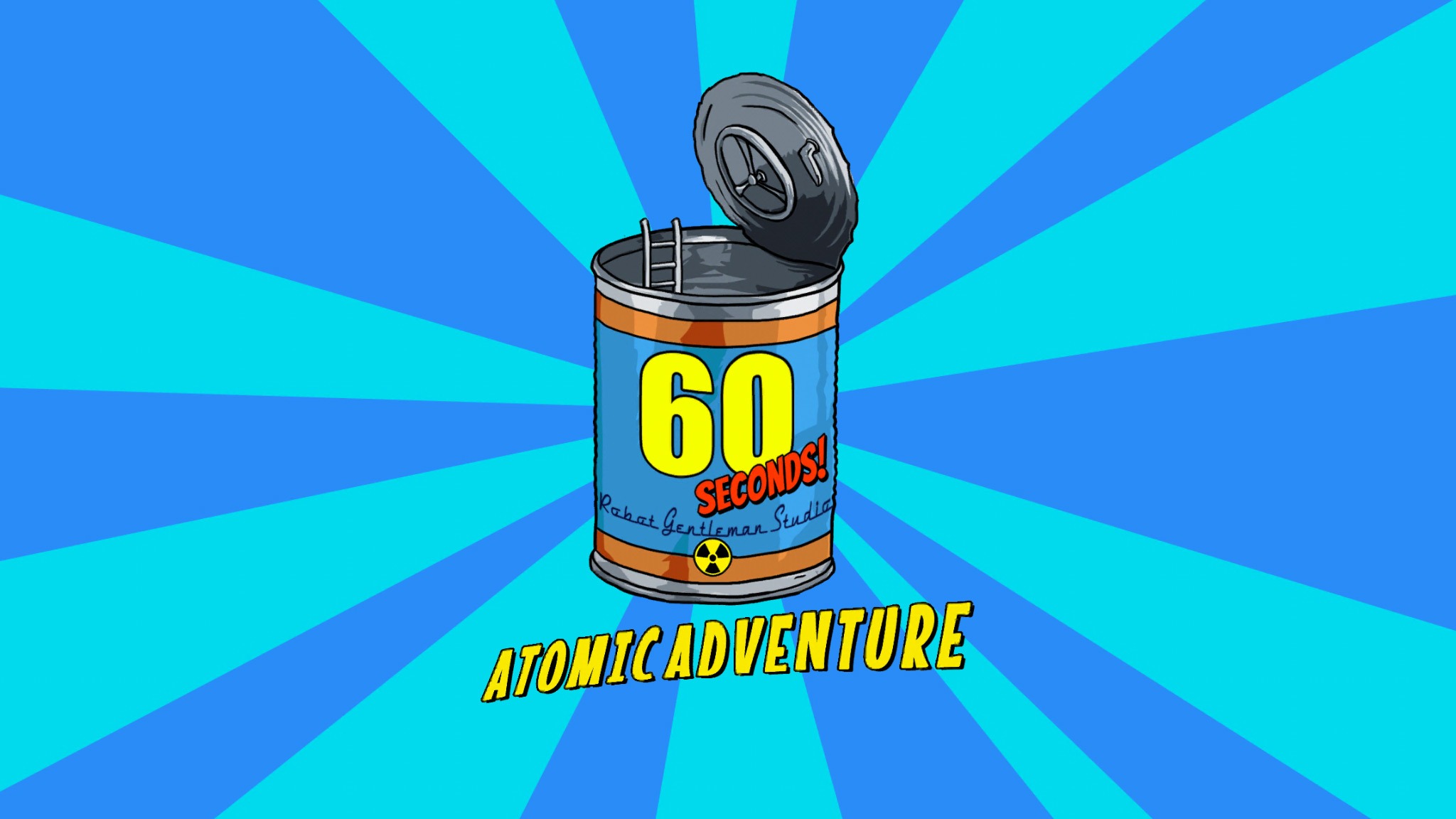
60 Seconds! Atomic Adventure is a survival simulation set in a nuclear era 1950’s suburbia. In this game, players must scavenge for supplies and then survive a nuclear fallout for as long as possible with those supplies. Gamezebo’s 60 Seconds! Atomic Adventure tips, cheats and strategies will help you keep it together while eating nothing but canned soup for weeks straight.
Game Basics
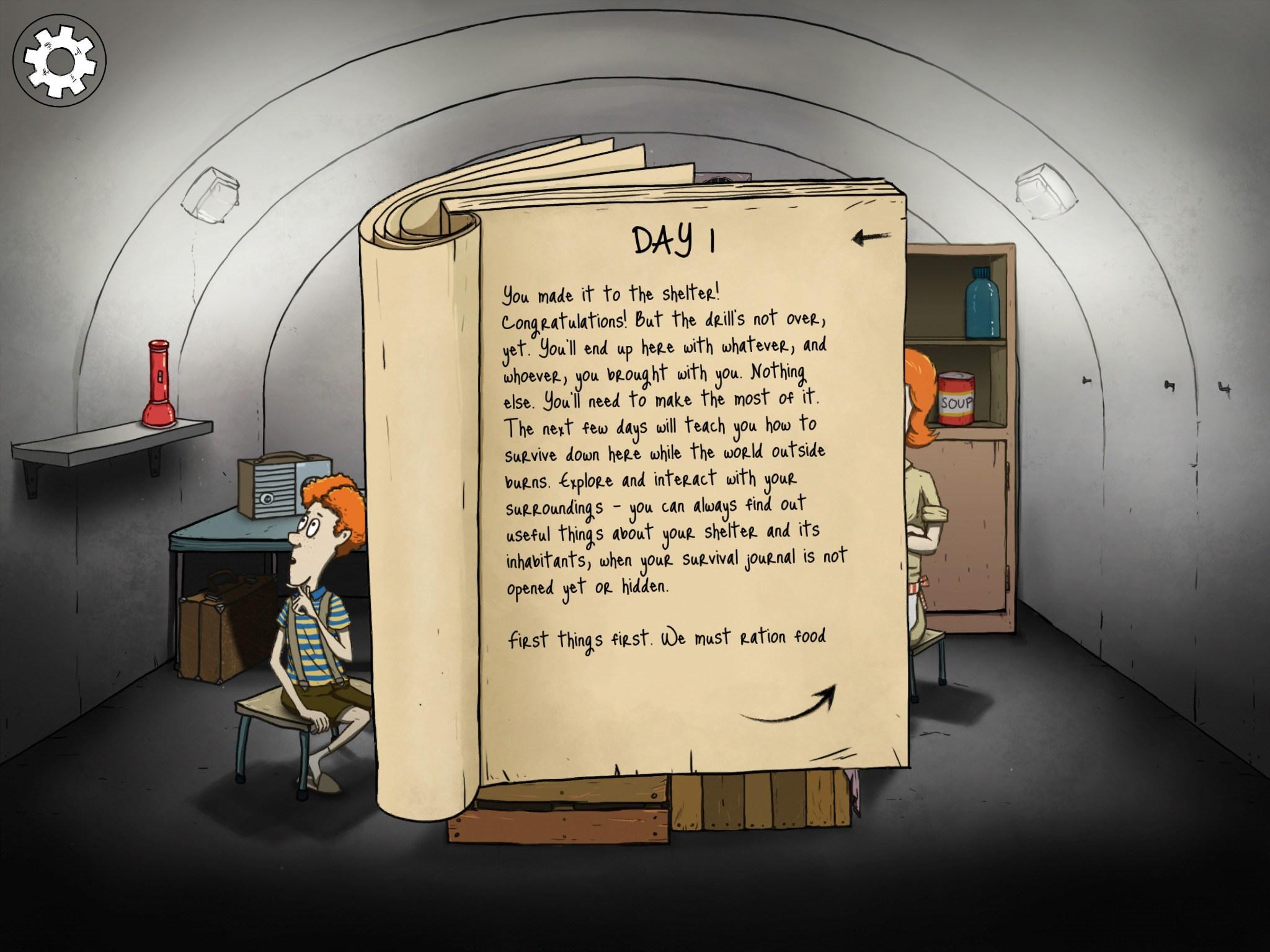
There are two portions to a full “Apocalypse!” playthrough of 60 Seconds: Scavenge and Survival. In the Scavenge portion, you’ll have 60 seconds to run around your house , picking up supplies and depositing them in your fallout bunker. The items (and family members) you manage to get inside the bunker before the minute is up will then be used in the Survival portion.
This second part of the game is the main focus and much longer: Survival is presented more as an interactive choose-your-own-adventure where you will read through each day’s events and make decisions, such as how to ration food and water, whether to send anyone to the surface, and how to handle random events that occur. The goal of Survival is to last until you are rescued in some fashion.
If you prefer one of these portions over the other, you can choose to play just that section from the menu. However, only Survival has an actual win-state: if you play Scavenge the game just sort of fades out after you get into the bunker. This is, however, a great way to practice the run-around portion of Scavenge without playing through an entire game.
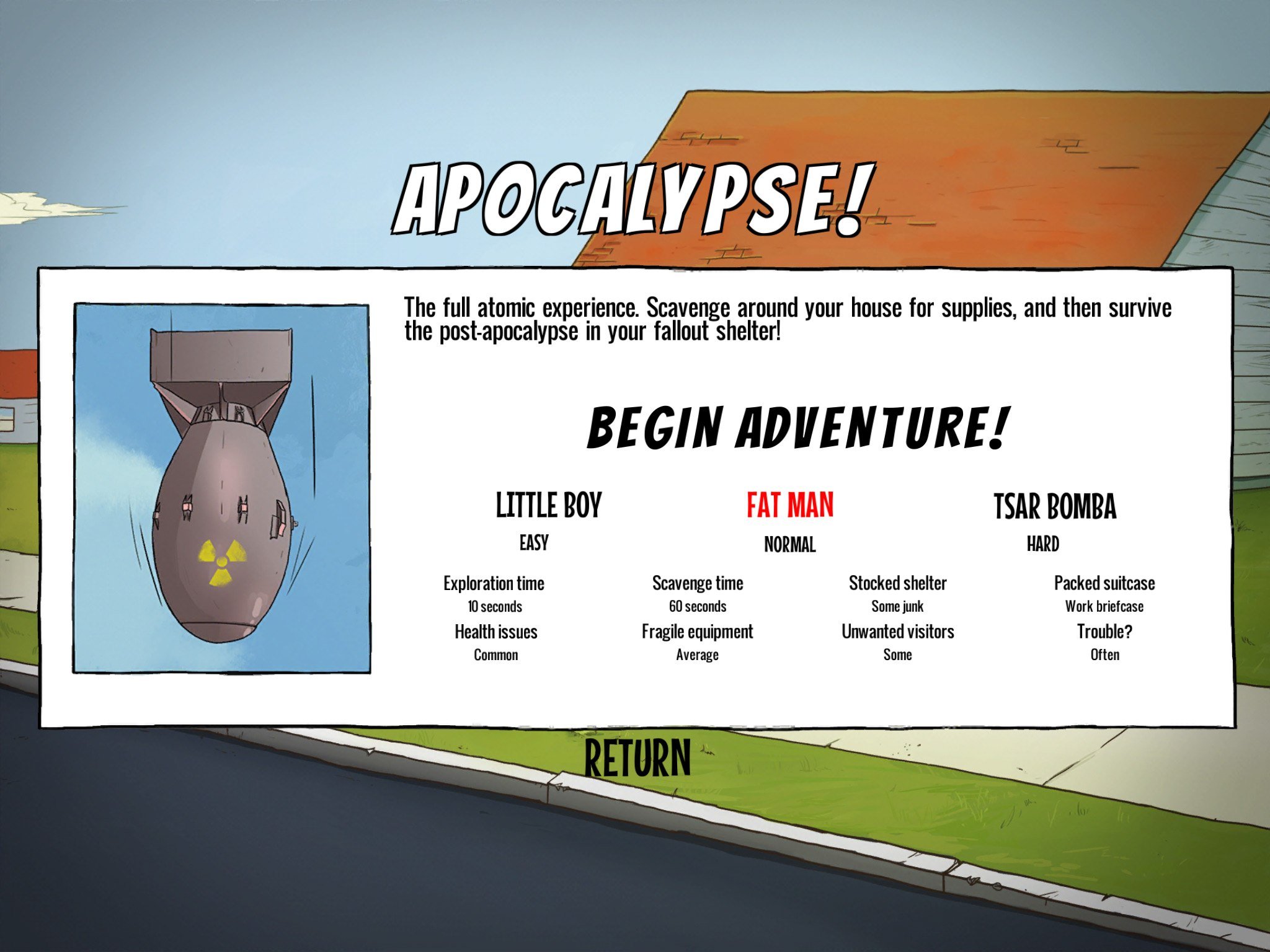
Besides the game mode, the other choice you have to make before getting started is the difficulty. Each difficulty level outlines what it entails, including:
- Exploration time: How long you get to wander around the house before the bombs drop. More exploration time means more time to figure out a plan of attack for Scavenge.
- Scavenge time: How long you get to run around the house picking up items. (This is always set at 60 seconds on every game mode.)
- Stocked shelter: How many items you’ll start with in your shelter on Day 1 of Survival. These are items that are given to you freely without having to collect them in Scavenge. You’ll usually be given additional food, water, and occasionally some equipment.
- Packed suitcase: The type of items you’ll get in your suitcase, if you manage to pick it up during Scavenge. Easy contains “holiday luggage” (two items) and Normal contains “work suitcase” (one item). The items you get are random, but they’re typically equipment like the shotgun or gas mask, as opposed to food or water.
- Health issues: How easily your survivors become sick, insane, etc.
- Fragile equipment: How easily your items break when used.
- Unwanted visitors: How often outsiders—threatening or friendly, human or otherwise—will show up at your bunker door.
- Trouble?: How often you’ll encounter challenges. On easier modes, you’ll often have days of just thinking about the past and nothing specifically bad happening. More trouble means more difficult daily events.
Tips
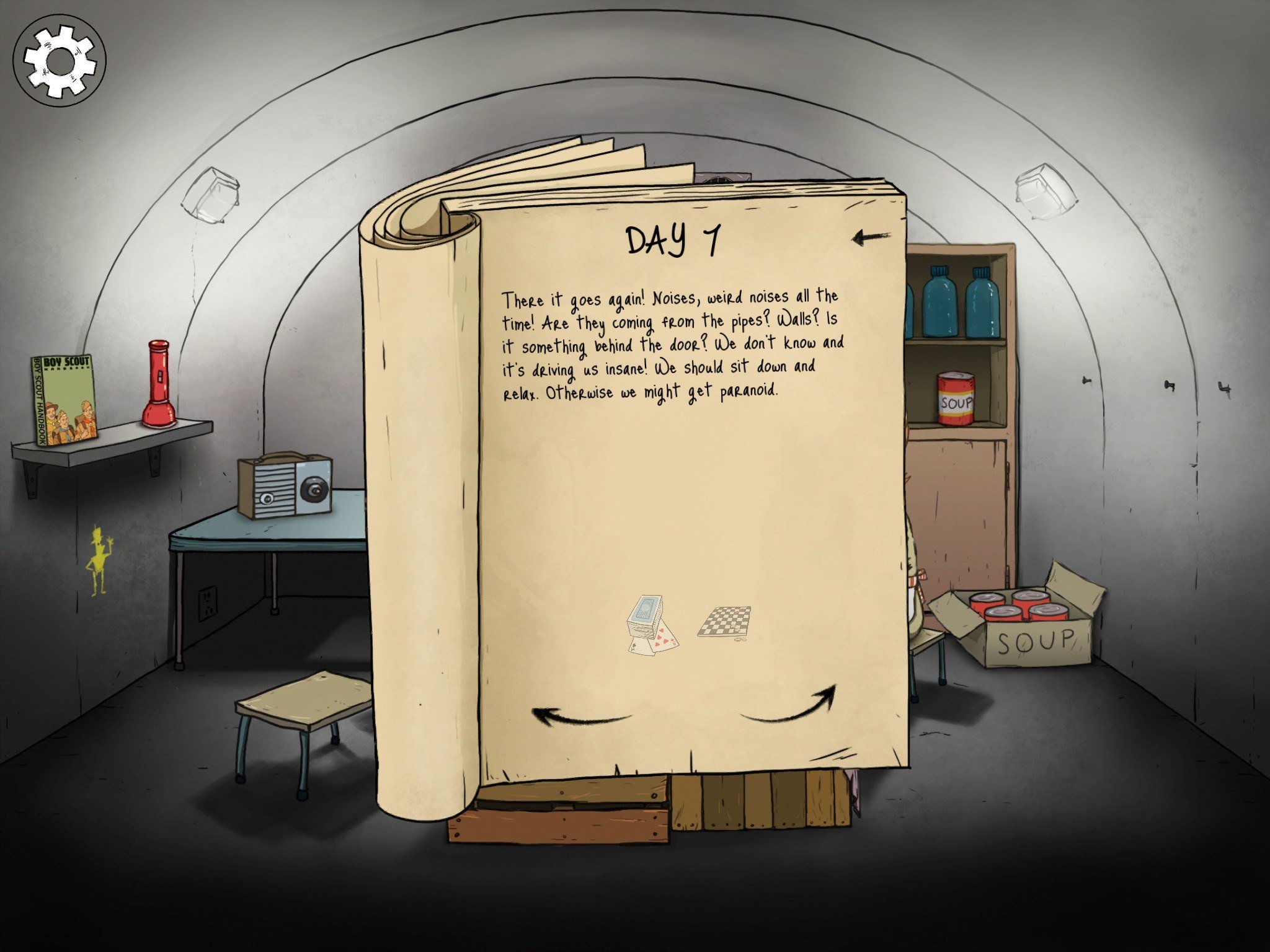
- Every item has a use. When you’re running around with only 60 seconds to collect all the gear you’ll need, it might seem like a waste of valuable carrying space to pick up a deck of cards. However, every item you can add to your bunker has some value. The first is in its intrinsic effect—playing cards, for instance, can be used to ward off insanity from being cooped up in a tiny room for weeks on end. Besides this, however, you never know what items will be used in your eventual escape, or requested from traders that come to your door. You may be able to trade those playing cards for a working radio. Or the army may ask you to mark your location discreetly with certain cards. Both of these scenarios can, and did, happen to us.
- Focus on quantity over quality. Per the note above, it’s better to grab a lot of stuff than to waste time navigating to very specific items. Sometimes the randomized house will give you a completely stocked kitchen with tons of food. Grabbing four cans in a single trip is more effective than grabbing a couple cans and moving on because you don’t want to overstock on food (which is, really, not possible).
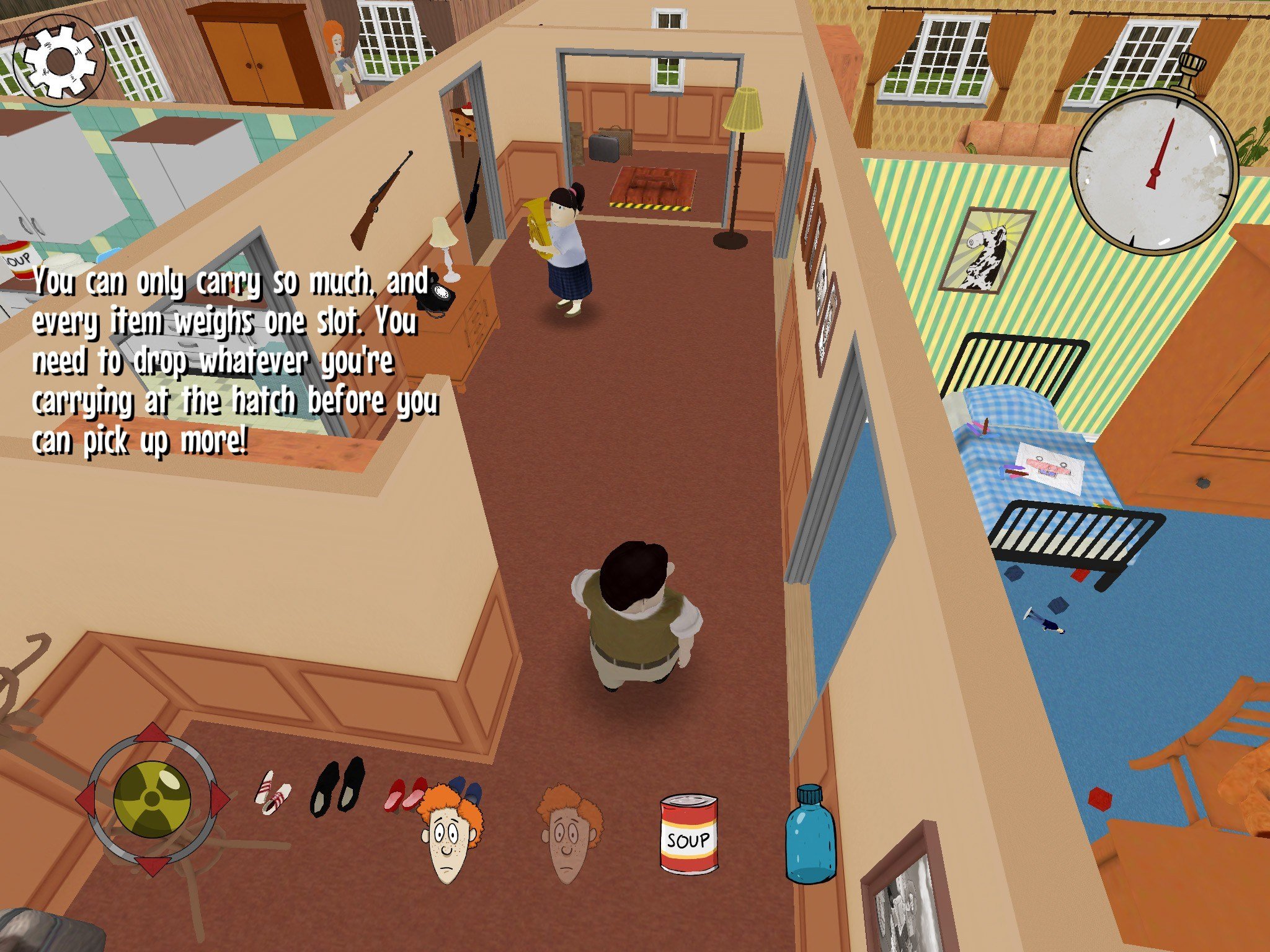
- Family first. While you’ll be able to trade or scavenge for essentially any other item in the game, you cannot scavenge for new family members. There are four family members total in the house—your character, Ted; your daughter, Mary Jane; your wife, Dolores; and your son, Timmy. Bringing all four family members into the bunker will make your rations deplete faster, but will ultimately be useful in the long run. It ensures you have someone healthy and capable of going out into the wasteland even when other family members are sick and provides a buffer if someone does die. Think of the family members as extra lives: if only Ted makes it into the bunker, you’re on your last life.
- Water, food, gas mask. Item-wise, if you want to make a mental plan of what else to grab besides your family, there are some items that are more useful in the beginning stages of Survival. Water is more important than food, as your survivors can last only four days without water but ten without food. This means you’ll be going through water more than twice as fast. For equipment, we recommend trying to grab the gas mask if it’s within easy reach. Within the first 15-20 days of Survival, the surrounding area will be severely irradiated. Trying to go out on scavenging trips will result in your family member getting sick unless they take a gas mask with them. Again, it’s better to have a lot of stuff than specific items, but these three are never bad choices.
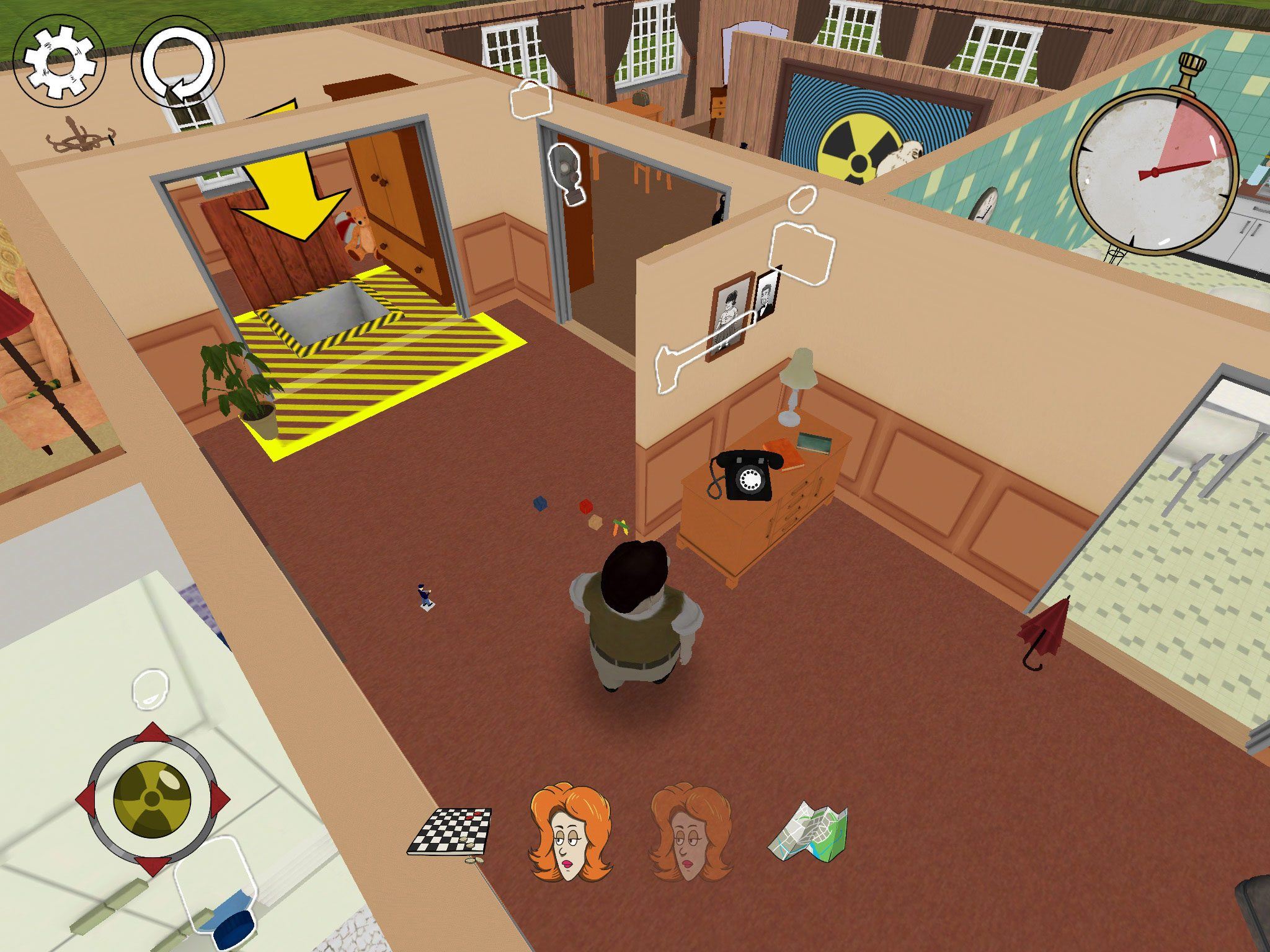
- Learn the outlines. Since the house’s stock randomizes each playthrough, it’s helpful to recognize what each item’s white outline through the wall looks like—while locations change, the appearance of items never does. This way you’ll know if entering a room is useful before you physically bumble your way in. There may be times when an entire room isn’t worth entering, but you’ll only know by checking what you can see through the walls. Food, for instance, is a flat-sided cylinder while water has a notched top.
It’s also helpful to remember how many spaces of capacity an item takes up so you don’t waste time trying to grab too much. The suitcase, for instance, takes up three spaces of your available four, so don’t try to grab it if you’re already carrying two other items. - The first couple of weeks are highly irradiated. Once you’re in the bunker, going outside to scavenge in the first 15-20 days runs a high risk of radiation poisoning. If someone goes out without a gas mask, they will almost certainly come back sick. Only go out scavenging if you 1) have a gas mask, 2) have a med kit you can use on the sick person, or 3) are willing to risk someone’s life. You’ll know it’s safe to go out without risk of radiation when you stop hearing the Geiger counter noise every morning and the diary stops warning you about the high levels of radiation.
- Survival is highly randomized. Events, as well as their outcomes, are random in Survival. The items the army will request before they can rescue you will change. The items offered by traders will change. The results of risk-taking will change. You might eat some mushrooms one playthrough and get violently ill while they will provide safe meals for weeks on another game. Just because something was bad (or good) on a previous playthrough doesn’t mean it will turn out the same this time around.

- …but some things never change. That said, there are certain truths to 60 Seconds. If you progress along the army’s plotline, they will eventually rescue you. If you go out during highly radioactive periods, you will risk getting sick. If you don’t give your survivors food or water for long enough, they will die.
- And some things are usually true. While most events have varied outcomes, there are certain choices that are usually better than others. When a family member seems sad or upset, it’s usually best to try talking to them. If a stranger stops by and asks for an item, it’s usually best to give it to them (if you can spare it). Sometimes refusing will have no consequences, but often being generous will result in unexpected rewards down the road. If there is a non-violent option available, go for it: not killing something may earn you a friend later on.
- Don’t send your sole survivor outside. If you’re down to only one family member in the bunker, don’t risk scavenging expeditions. There’s a very high chance that raiders or other factions will simply move into your bunker while you’re away, ending the game immediately. Just because you’re staying put doesn’t mean you can’t find new items: traders or other friendly factions may show up at your door with just the thing you need.
- Always listen to the radio. While there’s a chance the radio might break while using it, you might also hear from rescue teams, or learn about a nearby cache of items, or even learn how to repair one of your other broken items. The radio has tons of value and should not go unused.
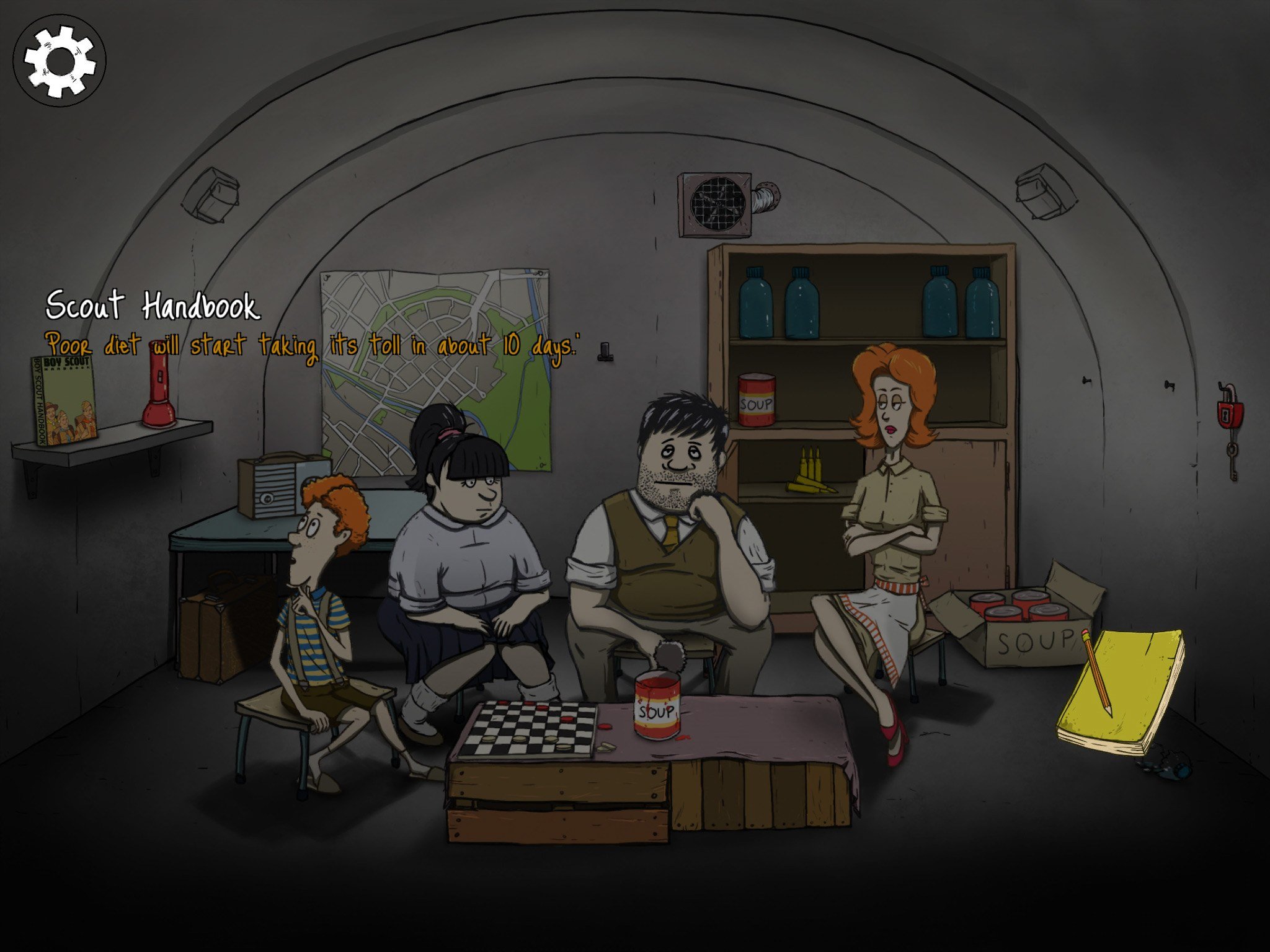
- Tapping on some bunker items provides info. If you happen to have the Scount Handbook in your bunker, tapping on it each day will give you a new in-game tip. Tapping on your water or food reserves will tell you how many you have of each. Tapping on family members will give you a quick glance of their current status. These are good ways to get a quick idea of who needs what or if you can spare a can of food to a passerby.
- Don’t scavenge with items you need in current storylines. When you send a survivor out on a scavenging expedition, any items they take with them will be unusable by the family members remaining behind. And when you’re pursuing a rescue plot, such as the army, you’ll generally need a specific item before you can move forward. For instance, when the army asked us to put out playing cards to mark our location: we could not move forward with the army until we had playing cards at our disposal. If we had given the playing cards to a survivor going on an expedition, and then the army had asked us for cards while they were away, we would not have been able to move forward and would have had to wait even longer for rescue.
- There are a lot more ways to lose than to win. You’ll likely lose quite a few games of 60 Seconds! before you ever see your survivors make it out of the bunker. Death by illness, starvation, dehydration, raider attack, bunker takeover, and so on are always looming threats. Meanwhile, it takes having specific items and sheer longterm survival to make it to the point of rescue. Don’t get too frustrated if you don’t make it: 60 Seconds! is about retrying, making different choices, and seeing how those choices probably lead to your demise again (but enjoying the trip).
More articles...
Monopoly GO! Free Rolls – Links For Free Dice
By Glen Fox
Wondering how to get Monopoly GO! free rolls? Well, you’ve come to the right place. In this guide, we provide you with a bunch of tips and tricks to get some free rolls for the hit new mobile game. We’ll …Best Roblox Horror Games to Play Right Now – Updated Weekly
By Adele Wilson
Our Best Roblox Horror Games guide features the scariest and most creative experiences to play right now on the platform!The BEST Roblox Games of The Week – Games You Need To Play!
By Sho Roberts
Our feature shares our pick for the Best Roblox Games of the week! With our feature, we guarantee you'll find something new to play!Type Soul Clan Rarity Guide – All Legendary And Common Clans Listed!
By Nathan Ball
Wondering what your odds of rolling a particular Clan are? Wonder no more, with my handy Type Soul Clan Rarity guide.







